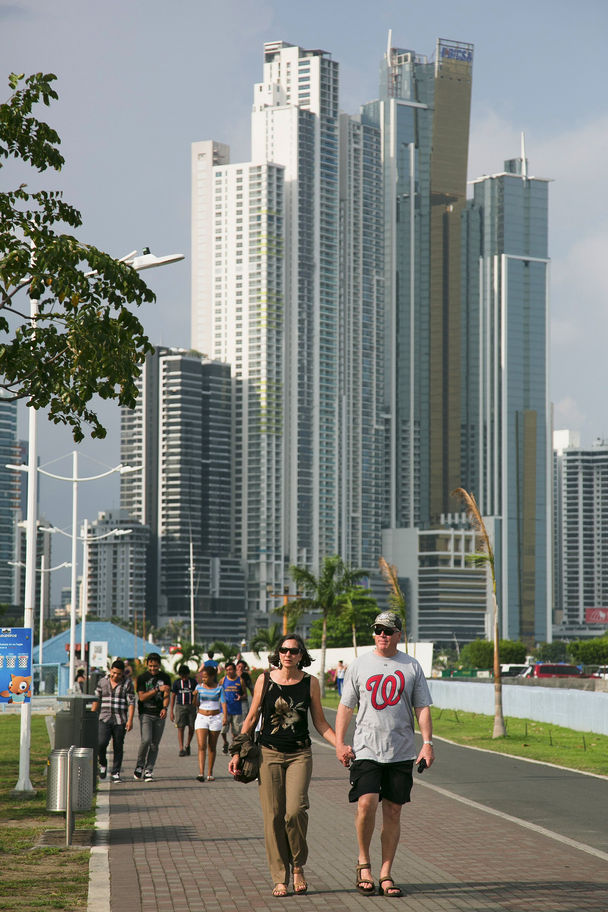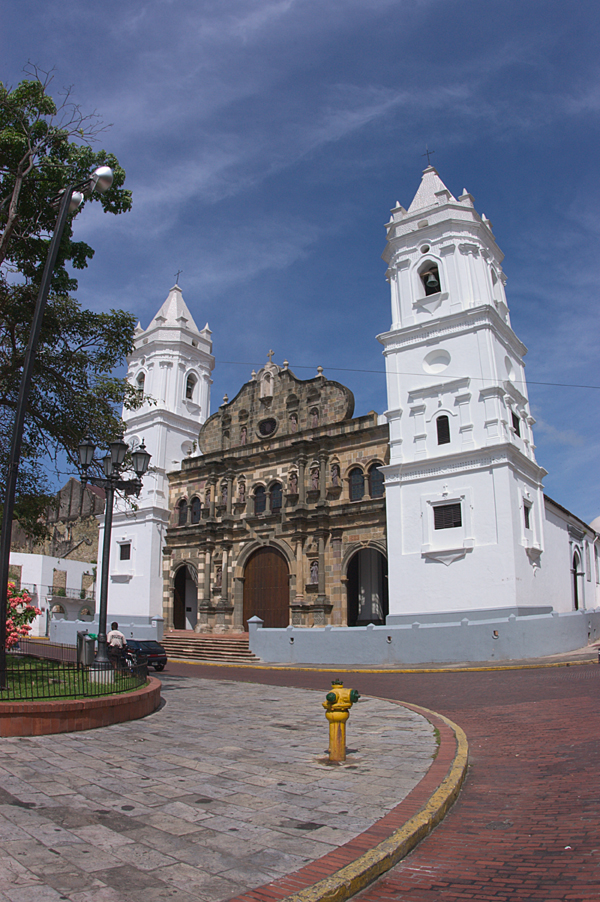Explore the exciting rebirth of Panama City
In a great article by Tim Neville of the NY Times, he explores the main streets of Panama City to the back alleys of the old city.
Traffic into Panama City was flowing for once, so Miguel Fabrega had only a moment to point out the crumbling ruins in the distance. They were the remains of a 16th-century New Spanish settlement that the British privateer Sir Henry Morgan eventually sacked in 1671. Ahead of us rose Old Panama’s modern replacement: a forest of green, blue and yellow glass skyscrapers that sifted the metallic Central American sky into great vertical columns.
“You’re going to hear a lot about identity, who we are and where we are going,” said Fabrega, a 37-year-old artist, writer and partner in a creative think tank called DiabloRosso, which promotes emerging artists in Panama.
Despite being founded in 1519, Panama is really only 13 years old, Fabrega argued, its birthday being Dec. 31, 1999, the day the United States gave the Panama Canal and its surrounding land back to the Panamanians. For the first time in a century the country was whole and independent.
“My generation inherited this blank canvas,” said Fabrega. “Now we have the chance to make it our own.”
Today, that canvas is far from blank, however. Over the past 13 years, Panama City has been racing to become a world-class metropolis, and for travelers, the changes have been enormous. In 1997 there were perhaps 1,400 hotel rooms in Panama City. Now there are more than 15,000 rooms with 4,582 more in the pipeline, according to STR Global, a London-based agency that tracks hotel markets. In the last two years alone, Trump, Starwood, Waldorf-Astoria, Westin and Hard Rock have opened hotels here. A new biodiversity museum designed by Frank Gehry is nearly complete. The country’s first modern dance festival unfolded last year, the same year Panama held its first international film festival. The Panama Jazz Festival is going strong after 10 years. The country even has its own year-old microbrewery.
“Panama was this compressed spring just ready to go,” said Keyes Christopher Hardin, a New York lawyer-turned-developer working to restore the city’s old colonial area. “When the Noriega dictator years ended and the U.S. returned all that canal land, things just took off. Everything that could go right did go right.”
Indeed, since 2008, when much of the world was in a recession, the Panamanian economy has expanded by nearly 50 percent. The canal itself, which frames the western edge of Panama City, is undergoing a $5.25 billion expansion that is expected to double its capacity and fuel even more economic growth.
Yes, Panama still struggles with crime and poverty, but foreigners are clearly intrigued with the way things are unfolding. In 1999 just 457,000 international tourists visited Panama, World Bank figures show. In 2011, more than 1.4 million came. Plenty are staying, too: sun-seeking Americans, Venezuelans and wealthy Colombian expatriates who are buying second homes and retirement properties all over Panama.
From slums to cocktail bars
In short, this city of about 880,000 people has gone from a ho-hum business center on the navy blue Pacific to a major leisure destination in record time. In doing so it has become a place full of the kind of paradoxes that occur whenever a very old place grinds against the very new. While the capital now has luxury apartments and five-star cuisine, the thing it needs most is a solid sense of identity.
In my spring visit, I hoped to get a sense of a city as it enters its teenage years. I would hike through slums where street merchants sold black magic spices, then change my shirt to sip $15 cocktails in the neon glamour of a Hard Rock bar. I would eat terrible chicken and wonderful octopus. I’d spend time with locals, expats, artists, entrepreneurs and a former gangster.
For now, Fabrega wanted to show me his interpretation of some of the changes afoot. We drove to Costa del Este, a section of the city with a skyline that looked like a concrete comb. Our destination was a pop-up gallery that had opened the night before inside an unfinished retail space at the bottom of a new white skyscraper. Sixteen of Fabrega’s abstract paintings with bright yellows, blues and reds hung on the concrete walls in an exhibition he called “Banana Republic.” It didn’t take long to spot some common motifs: finger-shapes that formed no hands, faucets that had no pipes and machines that could do no work.
“This is Panama,” Fabrega said with a shrug. “It’s beautiful, but it makes no sense.”
Panama has pretty much always been a bridge for cultures, conquerors and, well, birds, but once that mishmash gets distilled into the 50-some blocks of the colonial neighborhood of Casco Viejo, an eclectic, almost Noah’s Ark-like vibrancy prevails. The Chinese run so many small groceries here that Panamanians simply call the shops “Chinos.” The French left their mark on the corner of Avenida A and Calle 4, where a Parisian-style apartment building displays elegant rounded balconies. You hear German, Portuguese and English on the streets.
Parts of the area are still pretty seedy, though, and an elite division of stern-looking police officers patrol the area with machine guns and motorcycles. “I was definitely nervous about coming here at first, with the shootings and the gangs,” recalled Matt Landau, a New Jerseyan who moved to Panama City in 2006 and now owns Los Cuatro Tulipanes, a boutique hotel and apartment enterprise in Casco Viejo. A stray bullet smashed into the Canal House, the hotel where I stayed, in 2009, and Landau still warns guests not to wander beyond certain blocks. But Casco Viejo does feel quite safe, even at night, when the neighborhood comes alive with busy restaurants and rooftop bars. “I can’t begin to tell you how much it has all changed,” Landau said.
Old ‘Canal Zone’ transforms
Eager to explore more of the city, I met up with Jessica Ramesch, the Panama editor of International Living magazine. We piled into her Hyundai and fought our way out to a former U.S. military base called Clayton that sits along the canal in the northwest part of the city.
“All of this area was pretty much closed to Panamanians when the Americans were here,” she said as we crept through the Canal Zone, a Phoenix-size former U.S. territory where Americans working and defending the canal lived a strange, cross-world existence. “Zonians,” as they were called, could get Guess jeans and Jif peanut butter just as on most military bases abroad, but then monkeys might walk with the children to school. Huge ships moved through the Miraflores Locks just to the west of the road.
“Many Zonians stayed and some of the bases have become these gorgeous neighborhoods,” Ramesch said.
Clayton is one of them. Though it was now getting dark, I could see community centers and signs for the City of Knowledge, a compound for research, tech companies and nongovernmental organizations. We parked near a soccer field and wandered toward a massive corotu tree where a crowd had spread out blankets and lawn chairs. A band was warming up near the trunk.
While much of the city’s night life unfolds along Calle Uruguay, every full moon during the dry months hundreds of people head out to Clayton to bang on Tupperware containers, buckets and anything else that might make a noise. They do their best to follow the band — just a group of friends, really — which plays pop, reggae and whatever else it feels like.
“Who here can drum?” an announcer shouted into a microphone, and the pounding became a roar.
Over the next several days, few things I saw or did in the city had quite the same wow factor as this bucket band gathered under an old tree. I sipped cocktails at Barlovento, a new rooftop bar where slinky women and V-shaped men swirled around in a cyclone of perfume and cigarettes, and I shopped for tapestries made by Kuna Indians along a waterfront paseo. A hike on a steep, carless road up a jungly hill in the middle of the city stood out, but that’s because an anteater crossed my tracks, and I’d never seen one of those before.
But here on the ground with wine and cheese and a fat moon hanging in the trees, I wondered if a city needs to add up to make sense. As absurd as Panama City can feel at times, it is certainly a lot of fun, too, and between the cracks of all the chaos, these mini-miracles are burbling through.









